|
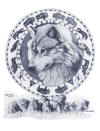
|
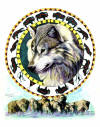
|
|
Buffalo Wolf is surrounded by the Circle of Life Sacred Hoop. He hunted the buffalo on the great plains of North America and when his family had eaten and filled their needs, he sang to invite the coyotes, foxes and birds to share in the feast. Any remains of the animal killed then returned to the Earth to fertilize the grasses and plants which in turn fed the other plains animals, from the mighty buffalo to the little mouse. Following the wolf's example, Native Americans shared their hunt with the widowed, orphaned, sick and elderly. The Buffalo Wolf was once one of the twenty-eight subspecies of wolf that roamed the North American Continent until man eliminated all but a recognized six species.
|

|
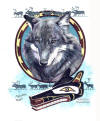
|
|
Alaskan Wolf - The Nunamiut of the far North confront polar darkness, blizzards, deep sub-zero weather and years in which caribou never come. They have learned to survive all this by emulating the wolf. They let the wolf teach them to hunt, to find water and to navigate the snowy terrain. The Nunamiut's ceremonial traditions and legends reflect their reverence for the wolf. Neither wolf nor Nunamiut hunt in bad weather. Both like to play and hunt vigorously and both get white hair with age. Both are tough, surviving some of Earth's harshest conditions. Both know the good hunting grounds, where the berries are to be found, and where creeks still run in August. Man and wolf have grown very much alike.
|
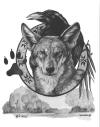
|
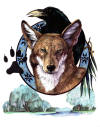
|
|
Red Wolf -Once thousands of red wolves roamed the Southeastern United States, but by 1980, hunting, disease, and environmental conditions left only a few of these small southern wolves. Efforts are underway to breed the wolf and even reintroduce Red Wolves into the wild. On the Sacred Hoop are symbols associated with the wolves - clouds, lightning and hail. It was believed that the wolf could influence the spirits of weather. In some traditions, the wolf guards the eastern door and is associated with the color red. The willow is sacred because of its eternal nature. If cut down, a new tree springs from the roots. The Raven is pictured because of its symbiotic relationship with the wolf.
|
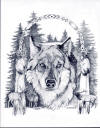
|
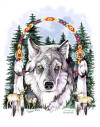
|
|
Timber Wolf - The eastern timber wolf (Canis lupus lycaon) was the first subspecies of the gray wolf, Canis lupus, to be recognized in the United States. Canis lupus lycaon inhabited the eastern portions of the United States and southeastern parts of Canada. Like all wolves, the eastern timber wolf is a very social animal which communicates using body language, scent marking, and vocalization.
The eastern timber wolf was virtually exterminated by the early 1900s throughout its historic range in the northeastern United States. Although there are unconfirmed sightings of wolves in Vermont and Maine, and a confirmed shooting of a wolf in Maine in 1993, there is no evidence of breeding activity in the region.
The northeastern United States provides suitable wolf habitat with over 26 million acres of northern forest from Adirondack State Park in Upstate New York through the North Woods of Maine. In fact, the U.S. Fish and Wildlife Service's 1992 Eastern Timber wolf Recovery Plan identified Adirondack State Park and 2 areas of New England as possible recovery areas for this subspecies. Despite the availability of habitat and prey, natural re-colonization is unlikely due to many landscape barriers, including the St. Lawrence Seaway and extensive urban areas.
Attitudes on the reintroduction of the wolf in the northeastern United States vary. In early 2000, Cornell completed and released a study of residents' attitudes and beliefs on wolf recovery. Researchers polled 422 Adirondack residents and another 501 residents from throughout the state. They found that Adirondack residents are fairly evenly split in their attitudes towards potential wolf restoration.
The alpha Male is chief in the pack. He is the leader functioning as a teacher, and watcher over the pack and the packs young. Unlike dogs, the male becomes an integral part of the family life, babysitting at times, protecting always, and keeping order in the pack. Here the Timber Wolf takes on the role as leader, chief, and honored elder. When the young are old enough, the pack will take them out into the forest. Those that return are hailed with such enthusiasm and joy, and from that point on will hunt with the pack.
|
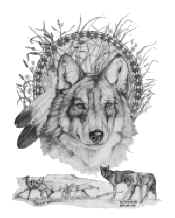
|
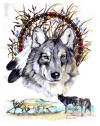
|
|
Prairie Wolf - The Great Plains wolf (Canis lupus nubilus) is the most common subspecies of the gray wolf in the continental United States. It currently inhabits the western Great Lakes region of the United States and Canada. A typical Great Plains wolf is between 4 1/2 and 6 1/2 feet long, from snout to tail, weighs from 60 to 110 pounds, and may have a coat of gray, black or buff with red-ish coloring. Like all wolves, the Great Plains wolf is a very social animal that communicates using body language, scent marking and vocalization with an average pack size of five to six wolves. The territory size for the Great Plains wolf depends on the type and density of prey. Typical prey for the Great Plains wolf consists of white-tailed deer, moose, beaver, snowshoe hare, and smaller birds and mammals.
The historic range of the Great Plains wolf was throughout the United States and the southern regions of Canada. By the 1930s, Great Plains wolves were extirpated almost eliminated completely, in much of the western United States.
In Wisconsin and Michigan, the Great Plains wolf was eradicated by the mid- 1960s. Only a small group of wolves survived in northeastern Minnesota along the Ontario border. In 1974, the Great Plains wolf in the Great Lakes region became fully protected as an endangered species. By 1978, Minnesota's wolf population had increased enough that the wolf was reclassified as threatened in Minnesota. The Great Plains wolf is found in the Eastern distinct population segment (DPS) categorized under the Endangered Species Act which is now awaiting new legislation to completely remove it from the endangered species list.
The estimated population for Great Plains wolves for 2004 in the United States was over 3,700 wolves. North and South Dakota officials have noted lone wolves, but evidence indicates that the wolves were dispersers from populations outside the Dakotas.
|
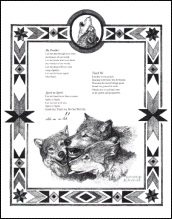
|
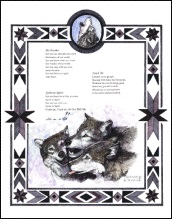
|
|
Wolf Song
My Brother:
Let me see through your eyes the beauty of our world.
Let me know what you know; the wonder of our world.
Let me sing with you, your song of praise.
Let me feel your spirit; your heart.
Teach Me:
Loyalty to my people. Sharing with those less fortunate,
Wariness for not all things are good
Stand my ground in truth
Obedience to spiritual laws
To be useful and purposeful.
Spirit to Spirit
Let my heart be as free as yours.
Spirit to Sprit
let me run with you.
Spirit to Spirit,
Guide me, Teach me, Be one with Me.
Niyawehnsie
|

